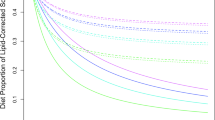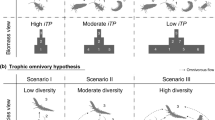Abstract
Stable isotope mixing models are often used to quantify source contributions to a mixture. Examples include pollution source identification; trophic web studies; analysis of water sources for soils, plants; or water bodies, and many others. A common problem is having too many sources to allow a unique solution. We discuss two alternative procedures for addressing this problem. One option is a priori to combine sources with similar signatures so the number of sources is small enough to provide a unique solution. Aggregation should be considered only when isotopic signatures of clustered sources are not significantly different, and sources are related so the combined source group has some functional significance. For example, in a food web analysis, lumping several species within a trophic guild allows more interpretable results than lumping disparate food sources, even if they have similar isotopic signatures. One result of combining mixing model sources is increased uncertainty of the combined end-member isotopic signatures and consequently the source contribution estimates; this effect can be quantified using the IsoError model (http://www.epa.gov/wed/pages/models/isotopes/isoerror1_04.htm). As an alternative to lumping sources before a mixing analysis, the IsoSource mixing model (http://www.epa.gov/wed/pages/models/isosource/isosource.htm) can be used to find all feasible solutions of source contributions consistent with isotopic mass balance. While ranges of feasible contributions for each individual source can often be quite broad, contributions from functionally related groups of sources can be summed a posteriori, producing a range of solutions for the aggregate source that may be considerably narrower. A paleohuman dietary analysis example illustrates this method, which involves a terrestrial meat food source, a combination of three terrestrial plant foods, and a combination of three marine foods. In this case, a posteriori aggregation of sources allowed strong conclusions about temporal shifts in marine versus terrestrial diets that would not have otherwise been discerned.




Similar content being viewed by others
References
Bearhop S, Thompson DR, Waldron S, Russell IC, Alexander G, Furness RW (1999) Stable isotopes indicate the extent of freshwater feeding by cormorants Phalacrocorax carbo shot at inland fisheries in England. J Anim Ecol 36:75–84
Ben-David M, Flynn RW, Schell DM (1997a) Annual and seasonal changes in diets of martens: evidence from stable isotope analysis. Oecologia 111:280–291
Ben-David M, Hanley TA, Klein DR, Schell DM (1997b) Seasonal changes in diets of coastal and riverine mink: the role of spawning Pacific salmon. Can J Zool 75:803–811
Ben-David M, Titus K, Beier LR (2004) Consumption of salmon by Alaskan brown bears: a trade-off between nutritional requirements and the risk of infanticide? Oecologia 138:465–474
Burford MA, Sellars MJ, Arnold SJ, Keys SJ, Crocos PJ, Preston NP (2004) Contribution of the natural biota associated with substrates to the nutritional requirements of the post-larval shrimp, Penaeus esculentus (Haswell), in high-density rearing systems. Aquaculture Res 35:508–515
Cramer VA, Thorburn PJ, Fraser GW (1999) Transpiration and groundwater uptake from farm forest plots of Casuarina glauca and Eucalyptus camaldulensis in saline areas of southeast Queensland, Australia. Agric Water Manage 39:187–204
Dawson TE, Mambelli S, Plamboeck AH, Templer PH, Tu KP (2002) Stable isotopes in plant ecology. Annu Rev Ecol Syst 33:507–559
Felicetti LA, Schwartz CC, Rye RO, Haroldson MA, Gunther KA, Phillips DL, Robbins CT (2003) Use of sulfur and nitrogen stable isotopes to determine the importance of whitebark pine nuts to Yellowstone grizzly bears. Can J Zool 81:763–770
Fry B (2003) Steady state models of stable isotopic distributions. Isot Environ Health Stud 39:219–232
Gannes LZ, Martinez del Rio C, Koch P (1998) Natural abundance variations in stable isotopes and their potential uses in animal physiological ecology. Comp Biochem Physiol 119A:725–737
Hobson KA (1990) Stable isotope analysis of marbled murrelets: evidence for freshwater feeding and determination of trophic level. Condor 92:897–903
Lathja K, Michener RH (eds) (1994) Stable isotopes in ecology and environmental science. Blackwell, London
Melville AJ, Connolly RM (2003) Spatial analysis of stable isotope data to determine primary sources of nutrition for fish. Oecologia 136:499–507
Newsome SD, Phillips DL, Culleton BJ, Guilderson TP, Koch PL (2004) Dietary reconstruction of an early to middle Holocene human population from the central California coast: insights from advanced stable isotope mixing models. J Archaeol Sci 31:1101–1115
Phillips DL (2001) Mixing models in analyses of diet using multiple stable isotopes: a critique. Oecologia 127:166–170
Phillips DL, Gregg JW (2001) Uncertainty in source partitioning using stable isotopes. Oecologia 127:171–179
Phillips DL, Gregg JW (2003) Source partitioning using stable isotopes: coping with too many sources. Oecologia 136:261–269
Phillips DL, Koch PL (2002) Incorporating concentration dependence in stable isotope mixing models. Oecologia 130:114–125
Rosing MN, Ben-David M, Barry RP (1997) Analysis of stable isotope data: a K nearest-neighbors randomization test. J Wildl Manage 62:380–388
Sara G, Vizzini S, Mazzola A (2003) Sources of carbon and dietary habits of new Lessepsian entry Brachidontes pharaonis (Bivalvia, Mytilidae) in the western Meditteranean. Mar Biol 143:713–722
Sara G, Scilipoti D, Mazzola A, Modica A (2004) Effects of fish farming waste to sedimentary and particulate organic matter in a southern Mediterranean area (Gulf of Castellammare, Sicily): a multiple stable isotope study (d13C and d15N). Aquaculture 234:199–213
Schwarcz HP (1991) Some theoretical aspects of isotope paleodiet studies. J Archaeol Sci 18:261–275
Sonnerup RE, Quay PD, McNichol AP, Bullister JL, Westby TA, Anderson HL (1999) Reconstructing the oceanic C-13 Suess effect. Global Biogeochem Cycles 13:857–872
Still CJ, Berry JA, Ribas-Carbo M, Helliker BR (2004) The contribution of C3 and C4 plants to the carbon cycle of a tallgrass prairie: an isotopic approach. Oecologia 136:347–359
Sturges WT, Hopper JF, Barrie LA, Schnell RC (1993) Stable lead isotope ratios in Alaskan Arctic aerosols. Atmos Environ 27A:2865–2871
Acknowledgements
The information in this document has been funded in part by the US Environmental Protection Agency. It has been subjected to the Agency’s peer and administrative review, and approved for publication as an EPA document. Mention of trade names or commercial products does not constitute endorsement or recommendation for use. We thank Jon Benstead, Bob Ozretich, and two anonymous reviewers for constructive reviews. Table 1 and Figs. 1 and 3 are reprinted from Newsome et al. (2004) with permission from the publisher (Elsevier).
Author information
Authors and Affiliations
Corresponding author
Rights and permissions
About this article
Cite this article
Phillips, D.L., Newsome, S.D. & Gregg, J.W. Combining sources in stable isotope mixing models: alternative methods. Oecologia 144, 520–527 (2005). https://doi.org/10.1007/s00442-004-1816-8
Received:
Accepted:
Published:
Issue Date:
DOI: https://doi.org/10.1007/s00442-004-1816-8




